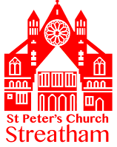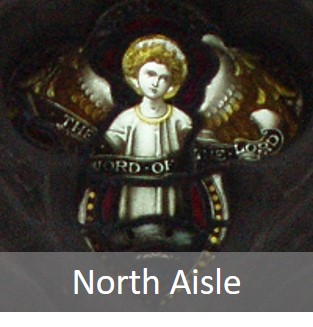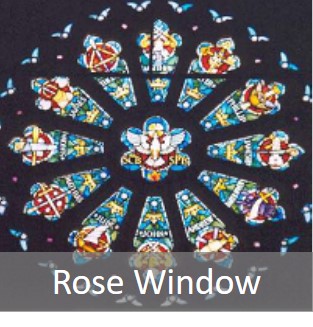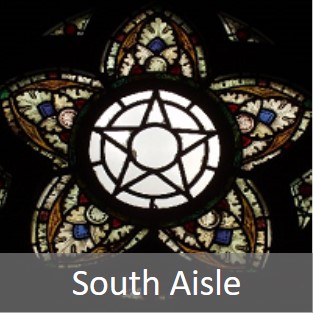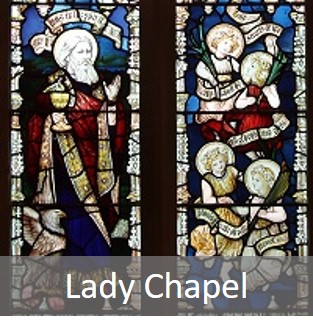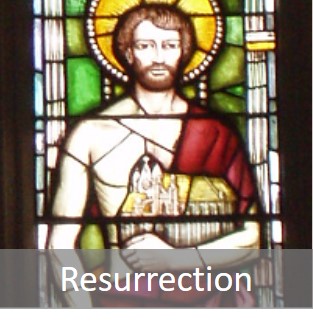Stained Glass – Sacramental Windows
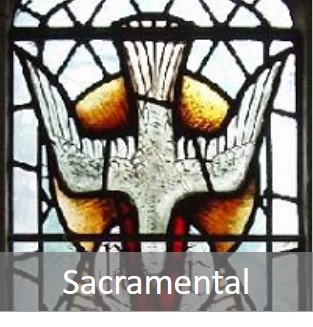
These windows were installed in the early 1950s to designs by Lawrence Lee.
The nine panels represent the sacraments, with three central windows dedicated to Baptism and the remaining six to the other sacraments: Confession, Communion, Confirmation, Marriage, Holy Orders and Holy Unction.
The windows are full of symbolism and detail. The following analysis highlights the symbols from each of the windows.
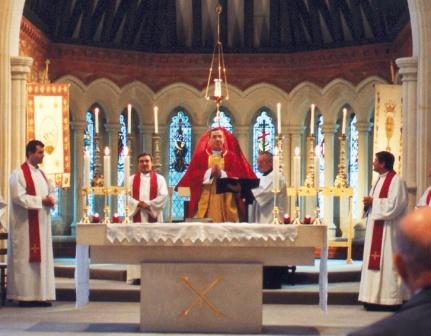
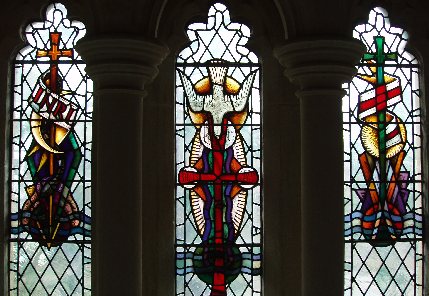
Centre Panel – Baptism
The centre panel has three windows dedicated to the sacrament of Baptism.
When we are baptised, the priest uses holy water to wash away our sins, as did John the Baptist when he immersed Jesus in the River of Jordon.
Baptism is the first sacrament that we receive and it is when the Holy Spirit enters into our lives.
Middle Window – Baptism
The middle window shows a symbol of the Holy Spirit, a Dove, descending.
The sign of the cross is shown in the centre forming the Trinity: God, Jesus and the Holy Spirit.
The priest makes the sign of the Trinity over the baptismal candidate and baptises them “In the name of the Father, the Son and the Holy Spirit.”
The vertical green and blue wavy lines show the Grace of Christ coming from the cross.
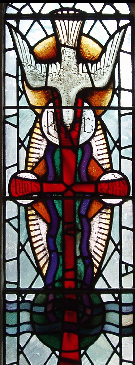
At the bottom of the design, you can see a circle representing the earth where the seed of faith is planted.
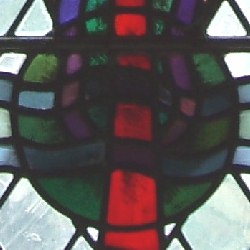
Blue wavy lines of baptismal water, probably representing the River of Jordan, flow across the bottom of every window.
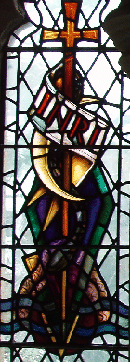
Centre Left Window- Death unto sin
The left and right-hand windows of the centre panel depict the themes from St Paul’s letter to the Romans – Chapter 6 verse 10.
“Death unto sin” and “Life unto righteousness”.
The inscription “INRI” represents Jesus’s death on the cross and the moon indicates our death – the waning of life.
St Paul wrote: “The death he dies, he died to sin, once for all; but the life he lives, he lives to God.”
Jesus died to wipe away our sins. He promises us eternal life once we die.
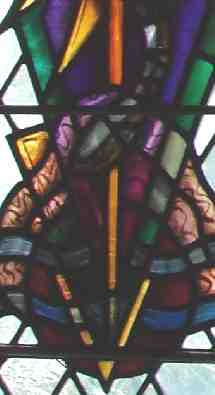
A serpent, or snake, is shown weaving its way down the window and at the bottom we again have a seed in the ground representing growth.
Centre Right Window – Life unto Righteousness
The right hand window of the middle panel shows us that through Jesus, God has given us eternal life. It is this life that we enter when we are baptised.
Life bursts from the seed at the bottom of the design.
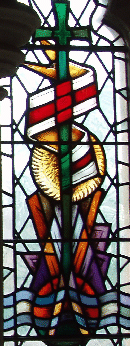
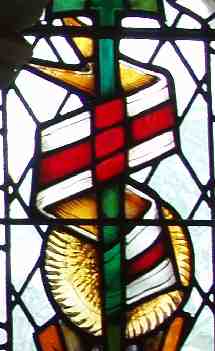
The red and white banner is the Resurrection Banner. Behind this a large sun is depicted representing life.
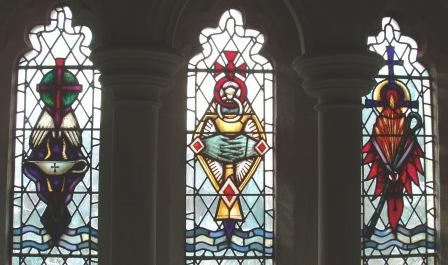
South Panel
- Holy Unction
- Holy Matrimony
- Holy Orders
Left Window – Holy Unction
The Sacrament of Holy Unction is also referred to as the anointing of the sick and as Last Rites. Last Rites are administered to those who are about to die.
Holy Unction can be administered simply by the priest laying on hands and allowing the holy spirit to flow to the sick person. However, it can also be accompanied by the priest making the sign of the cross on the person’s forehead with oil.
The sign of the cross is shown at the top with on an evergreen bed (life). At the bottom there is a black symbol of death reminding us of the role of Holy Unction for Last Rites.
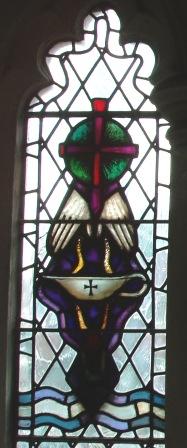
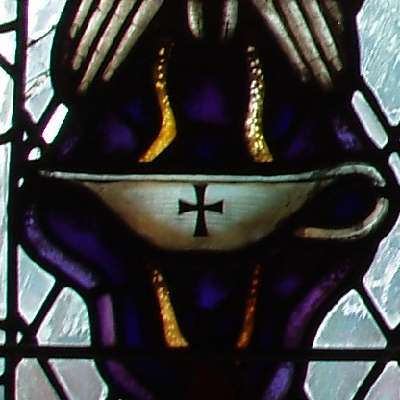
The priests hands are shown with the grace flowing from them and a vessel for the oil .
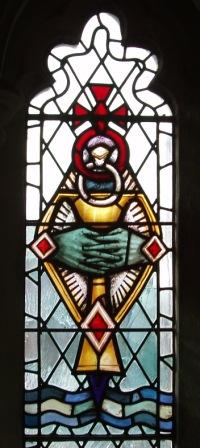
Centre Window – Holy Matrimony
It was Christ himself that elevated the act of a man and woman marrying to the level of a sacrament. Every sacrament has an outward visible sign, and for Holy Matrimony it is the man and the woman that are this sign.
The married couples hands are shown entwined around a loving cup. The loving cup is an ancient tradition. The bride and groom would drink the first toast at the wedding feast from the loving cup, the cup being passed down the generations and to the guests.
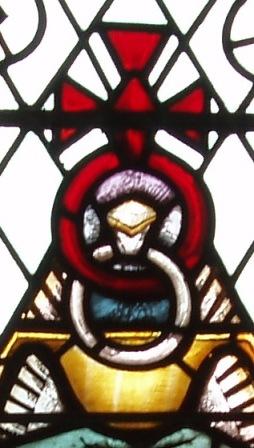
The red ring is a holy ring representing the sacramental aspect and it is linked to a wedding ring.
Right Window – Holy Orders
Holy Orders is the sacrament through which the mission entrusted by Christ to his apostles continues to be exercised in the Church until the end of time. Priests are ordained into holy orders.
At the top of the window is an early chistian symbol (in blue) – a sign of holiness.
The priests pastoral work is represented by a shepherd’s crook.
A ring – representing a priests marriage to the church is shown at the centre.
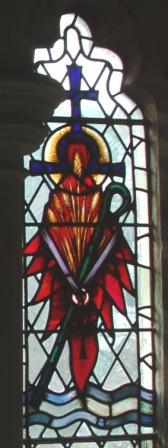
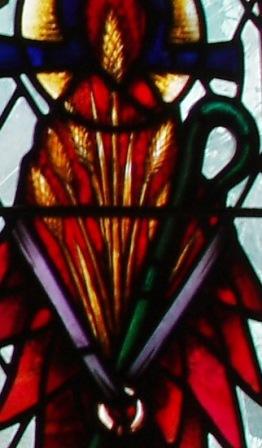
Wheat – represents the harvest of souls – and there is a background of fire representing the fire of the Holy Spirit.
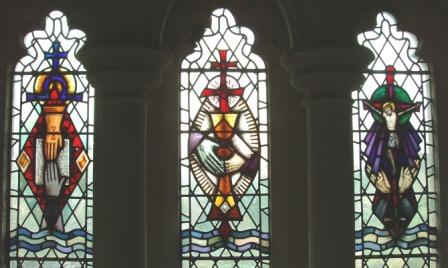
North Panel
- Confirmation
- Holy Communion
- Confession
Left Window – Confirmation
Confirmation marks the point in our Christian journey when participation in the life of God’s people, started at baptism, is confirmed by the bishop by the laying on of hands. Those who are baptised affirm for themselves the faith into which they have been baptised and their intention to live a life of responsible and committed discipleship.
Through prayer and the laying on of hands by the confirming bishop, the Church also asks God to give the candidate power through the Holy Spirit to enable them to live in this way.
The Holy Spirit is represented by the fiery red diamond and the blue cross signifies holiness.
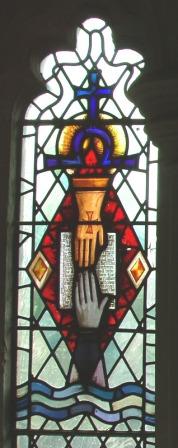
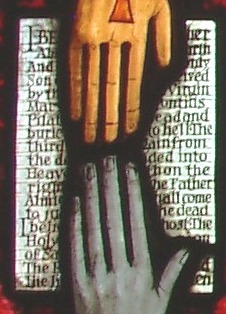
The hand of the Bishop is placed with the hand of the Confirmation candidate on a copy of the Nicene Creed.
The Nicene Creed represents faith.
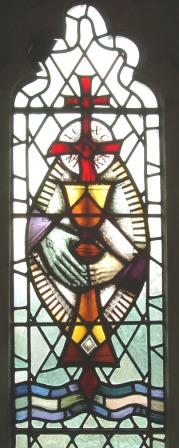
Centre Window – Holy Communion
Christians who are baptized and confirmed may receive Holy Communion. Holy Communion is a commemoration of the last supper of Jesus when he said eat this bread and drink this cup in remembrance of me. The bread represents Christ’s body and the wine his blood.
The window shows a chalice (or cup) with a priests hand joined with Christ’s hand.
Surrounding the image is an oval aureole – a device used to represent the presence of Christ.
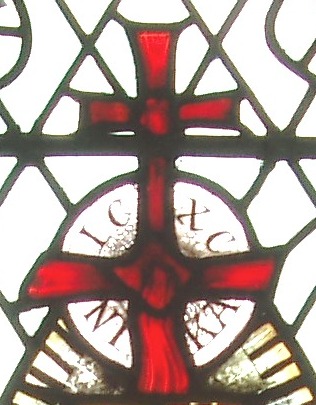
A communion wafer, representing the body of Christ, is shown behind a sign of the cross.
Right Window – Confession
Before taking Holy Communion we seek God’s forgiveness for our sins through a confession. This may be by visiting a priest to declare our sins and seek absolution (God’s forgiveness), or during the service of Holy Communion the entire congregation seek God’s forgiveness by saying:
“I confess to almighty God and to you, my brothers and sisters, that I have sinned through my own fault in my thoughts and in my words, and in what I have done, and in what I have failed to do; and I ask blessed Mary, ever virgin, and all the angels and saints, and you my brothers and sisters, to pray for me to the Lord our God.”
The cross is shown on a background of ‘evergreen’ representing life.
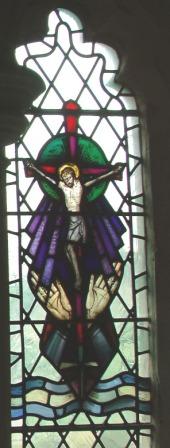
The hands of the sinner are shown receiving forgiveness flowing from the Cross.
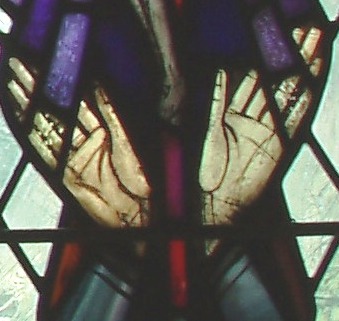
Jesus died on the cross to wipe away our sins – to give us the chance of eternal life.

